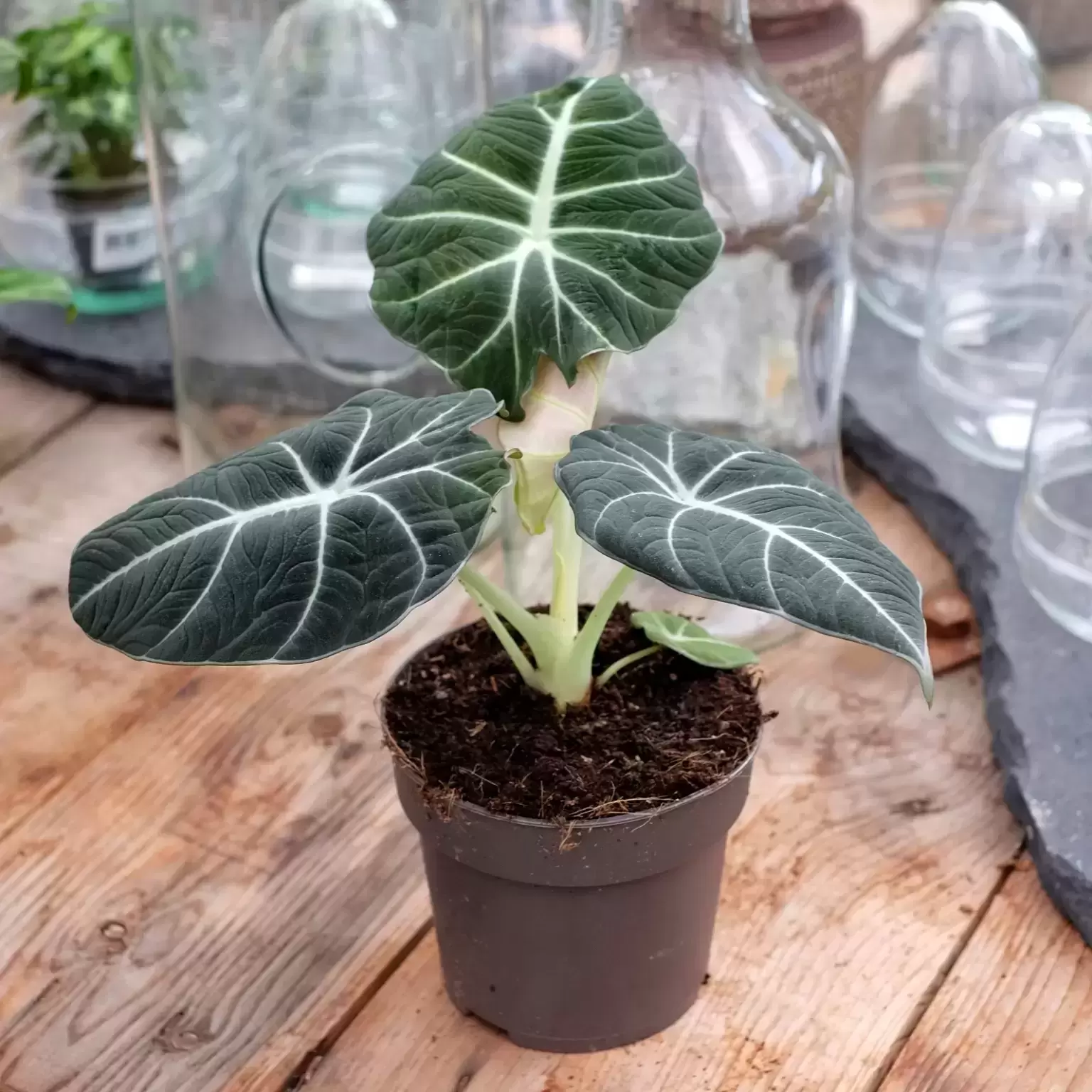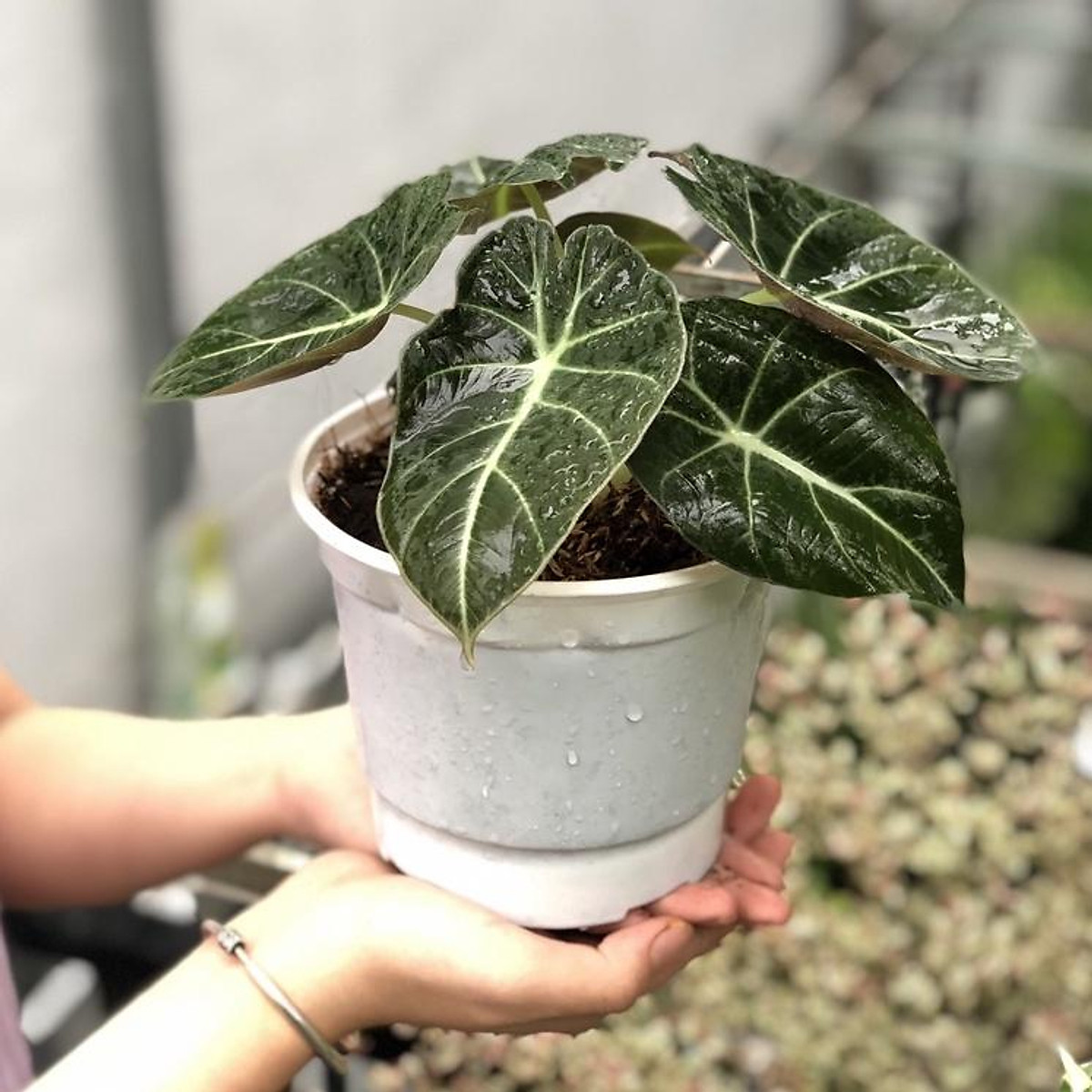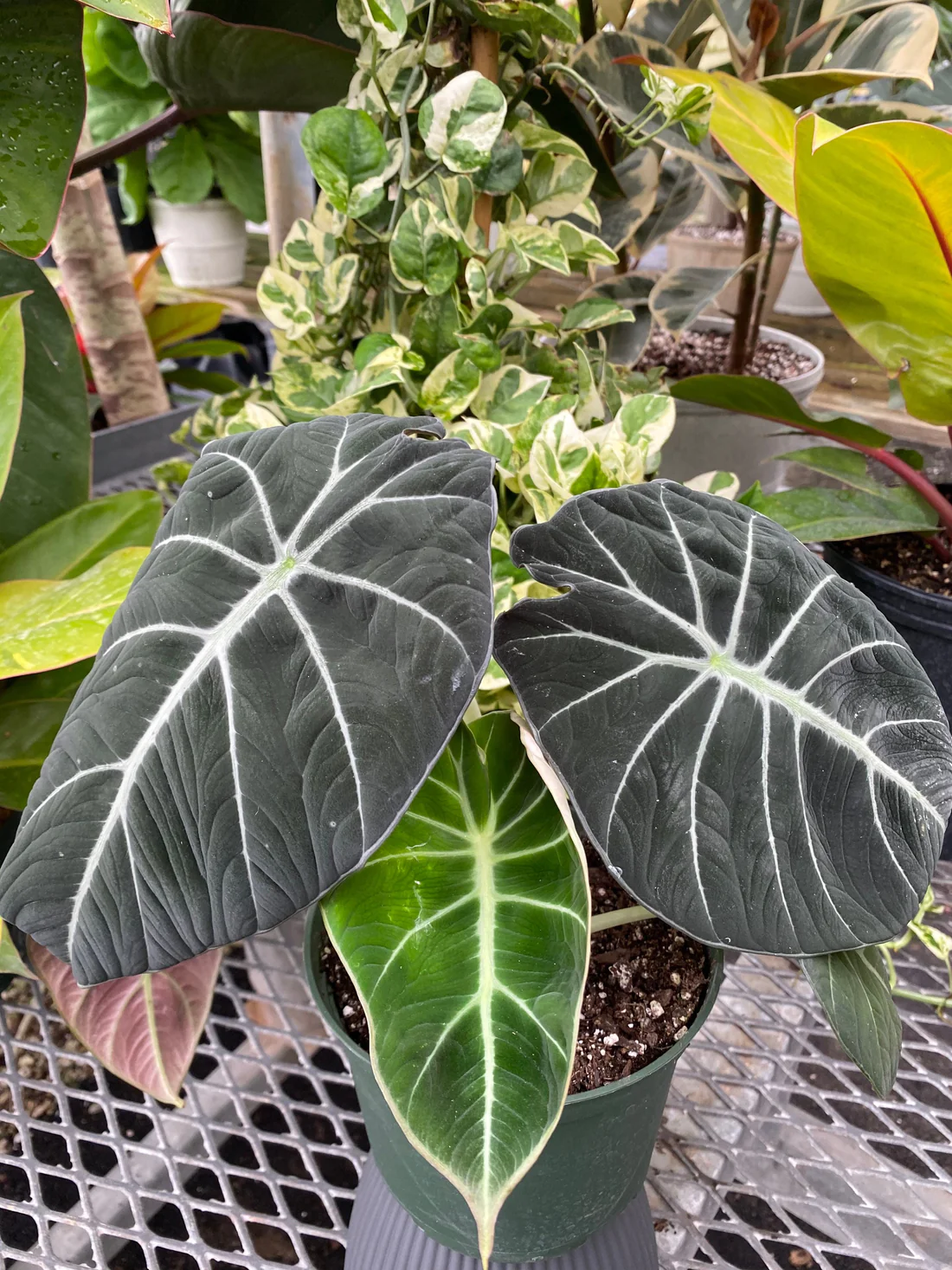Discover the Beauty of Alocasia Black Velvet - The Ultimate Guide
The Alocasia Black Velvet is a stunning indoor plant known for its dramatic, black-purple foliage. This exotic Alocasia makes a striking statement in any home or office. In this ultimate guide, we'll explore why the Alocasia Black Velvet has become so popular and how to care for it.

The Alocasia Black Velvet originates from the lush, tropical rainforests of Asia. It's a hybrid variety within the Alocasia genus created by cross-pollinating two different Alocasia species.
Natural Habitat Conditions
In its tropical habitat, the Black Velvet thrives in the following natural conditions:
- Warm temperatures between 60-85°F
- High humidity around 60-80%
- Shaded forest floors with dappled light
- Moist, rich soil and good drainage
Discovery and Propagation
The Black Velvet hybrid was first created and propagated in Thailand. Its dramatically dark leaves intrigued plant collectors and it quickly spread through the houseplant trade. Today, this hybrid is still mainly propagated by specialists in Asia and shipped to sellers internationally.
To understand more about the diverse origins and types of Alocasia, including those similar to the Black Velvet, refer to "5 Stunning Alocasia Types to Transform Your Space in 2023."
The Black Velvet is prized for its stunning leaves that emerge with a black-purple hue overlaying distinctive silvery veins.
Dramatic Dark Foliage
The deeply saturated dark purple to black foliage is the most defining feature of the Black Velvet hybrid. These unusual dark leaves have an iridescent sheen and feel velvety to the touch.
Prominent Veins
While the leaves are distinctly dark, the contrasting silver-colored veins stand out boldly. This lends beautiful texture and visual interest to the overall look of the plant.
Glossy Undersides
The undersides of the leaves have a striking purple-black gloss that makes this Alocasia glow. When light shines on the leaves, the color saturation pops even more.
Discover more about the distinctive features of various Alocasia plants in "5 Must-Know Secrets of Alocasia Plants."

"Discover the elegance of nature with Alocasia Black Velvet. Click now to bring this exquisite plant into your home!"
While beautiful, the Black Velvet does require some specific care in order to thrive indoors long-term.
Getting the Lighting Right
The Black Velvet prefers medium to bright indirect light. Low light will cause poor growth and leggy stems over time.
Optimal Light Conditions
- East facing windows - Provide bright indirect light all morning
- West facing windows - Offer after noon and evening bright light
- Direct southern exposure - Diffuse harsh light with sheer curtain
Too much direct sun will scorch and damage leaves. Filter bright light instead.
Maintaining the Ideal Temperature
Warm temperatures ranging 65-80°F are best to emulate the Alocasia's native tropical habitat.
Coping With Temperature Fluctuation
During winter when indoor temperatures may drop significantly at night, be sure to keep the plant away from cold drafts. Maintaining optimal daytime warmth can also help offset nighttime chill. Consider using a space heater or grow lights to provide additional ambient warmth around the Alocasia.
For comprehensive care tips that apply to Alocasia Black Velvet and similar plants, see "5 Tips to Grow Alocasia Indoors."

Providing Consistent Moisture
Establishing a regular, frequent watering routine is vital. The Black Velvet prefers consistently moist (but not waterlogged) soil.
Best Practices for Watering
- Check soil moisture 2-3 times per week
- Water thoroughly whenever top 1" of soil is dry
- Use room temperature filtered water
- Always dump out excess water in saucer
Inconsistent moisture causes stress, poor growth, and leaf burn. Sticking to a regimen is key!
Humidity is Crucial
Replicating tropical humidity is harder to achieve indoors but very important. Lack of humidity causes leaf browning/crisping. Target at least 50% humidity if possible.
Useful Humidifying Methods
- Use gravel trays or pebble trays
- Run household humidifiers nearby
- Mist leaves daily using room temperature filtered water
- Create a humidity tent or terrarium habitat
Boosting moisture in the surrounding air prevents drying of the Alocasia's foliage.
With its dramatically dark purple-black leaves contrasting prominent silvery veins, the Alocasia Black Velvet makes a standout addition to indoor plant collections. Caring for this exotic tropical hybrid by providing adequate warm temperatures, humid air, filtered bright light, and consistent soil moisture enables this beautiful Alocasia to thrive. The Black Velvet's lush, visually striking foliage brings rich texture and intrigue to any space.
- What is Alocasia Black Velvet and what makes it unique? Alocasia Black Velvet is a distinctive houseplant known for its lush, velvety dark leaves and striking white veins. Its compact size and dramatic appearance make it a popular choice for indoor plant enthusiasts.
- How do I care for my Alocasia Black Velvet? This plant thrives in bright, indirect light and requires well-draining soil. Water it when the top inch of soil feels dry, and maintain high humidity around the plant. Avoid overwatering to prevent root rot.
- Is Alocasia Black Velvet pet-friendly? No, Alocasia Black Velvet is not pet-friendly. It contains calcium oxalate crystals, which can be toxic if ingested by pets. It's best to keep this plant out of reach of curious pets.
- How often should I fertilize my Alocasia Black Velvet? Fertilize your Alocasia Black Velvet every 4-6 weeks during the growing season (spring and summer) with a balanced, water-soluble fertilizer. Reduce feeding in fall and winter when the plant's growth slows down.
- Can Alocasia Black Velvet grow in low light conditions? While Alocasia Black Velvet can tolerate low light, it thrives best in bright, indirect light. Low light conditions may lead to slower growth and less vibrant leaf coloration.
https://bit.ly/3Sqrdw8

Origins of the Alocasia Black Velvet
The Alocasia Black Velvet originates from the lush, tropical rainforests of Asia. It's a hybrid variety within the Alocasia genus created by cross-pollinating two different Alocasia species.
Natural Habitat Conditions
In its tropical habitat, the Black Velvet thrives in the following natural conditions:
- Warm temperatures between 60-85°F
- High humidity around 60-80%
- Shaded forest floors with dappled light
- Moist, rich soil and good drainage
Discovery and Propagation
The Black Velvet hybrid was first created and propagated in Thailand. Its dramatically dark leaves intrigued plant collectors and it quickly spread through the houseplant trade. Today, this hybrid is still mainly propagated by specialists in Asia and shipped to sellers internationally.
To understand more about the diverse origins and types of Alocasia, including those similar to the Black Velvet, refer to "5 Stunning Alocasia Types to Transform Your Space in 2023."
Unique Characteristics
The Black Velvet is prized for its stunning leaves that emerge with a black-purple hue overlaying distinctive silvery veins.
Dramatic Dark Foliage
The deeply saturated dark purple to black foliage is the most defining feature of the Black Velvet hybrid. These unusual dark leaves have an iridescent sheen and feel velvety to the touch.
Prominent Veins
While the leaves are distinctly dark, the contrasting silver-colored veins stand out boldly. This lends beautiful texture and visual interest to the overall look of the plant.
Glossy Undersides
The undersides of the leaves have a striking purple-black gloss that makes this Alocasia glow. When light shines on the leaves, the color saturation pops even more.
Discover more about the distinctive features of various Alocasia plants in "5 Must-Know Secrets of Alocasia Plants."

"Discover the elegance of nature with Alocasia Black Velvet. Click now to bring this exquisite plant into your home!"
Caring For Your Alocasia Black Velvet
While beautiful, the Black Velvet does require some specific care in order to thrive indoors long-term.
Getting the Lighting Right
The Black Velvet prefers medium to bright indirect light. Low light will cause poor growth and leggy stems over time.
Optimal Light Conditions
- East facing windows - Provide bright indirect light all morning
- West facing windows - Offer after noon and evening bright light
- Direct southern exposure - Diffuse harsh light with sheer curtain
Too much direct sun will scorch and damage leaves. Filter bright light instead.
Maintaining the Ideal Temperature
Warm temperatures ranging 65-80°F are best to emulate the Alocasia's native tropical habitat.
Coping With Temperature Fluctuation
During winter when indoor temperatures may drop significantly at night, be sure to keep the plant away from cold drafts. Maintaining optimal daytime warmth can also help offset nighttime chill. Consider using a space heater or grow lights to provide additional ambient warmth around the Alocasia.
For comprehensive care tips that apply to Alocasia Black Velvet and similar plants, see "5 Tips to Grow Alocasia Indoors."

Providing Consistent Moisture
Establishing a regular, frequent watering routine is vital. The Black Velvet prefers consistently moist (but not waterlogged) soil.
Best Practices for Watering
- Check soil moisture 2-3 times per week
- Water thoroughly whenever top 1" of soil is dry
- Use room temperature filtered water
- Always dump out excess water in saucer
Inconsistent moisture causes stress, poor growth, and leaf burn. Sticking to a regimen is key!
Humidity is Crucial
Replicating tropical humidity is harder to achieve indoors but very important. Lack of humidity causes leaf browning/crisping. Target at least 50% humidity if possible.
Useful Humidifying Methods
- Use gravel trays or pebble trays
- Run household humidifiers nearby
- Mist leaves daily using room temperature filtered water
- Create a humidity tent or terrarium habitat
Boosting moisture in the surrounding air prevents drying of the Alocasia's foliage.
Conclusion
With its dramatically dark purple-black leaves contrasting prominent silvery veins, the Alocasia Black Velvet makes a standout addition to indoor plant collections. Caring for this exotic tropical hybrid by providing adequate warm temperatures, humid air, filtered bright light, and consistent soil moisture enables this beautiful Alocasia to thrive. The Black Velvet's lush, visually striking foliage brings rich texture and intrigue to any space.
FAQ
- What is Alocasia Black Velvet and what makes it unique? Alocasia Black Velvet is a distinctive houseplant known for its lush, velvety dark leaves and striking white veins. Its compact size and dramatic appearance make it a popular choice for indoor plant enthusiasts.
- How do I care for my Alocasia Black Velvet? This plant thrives in bright, indirect light and requires well-draining soil. Water it when the top inch of soil feels dry, and maintain high humidity around the plant. Avoid overwatering to prevent root rot.
- Is Alocasia Black Velvet pet-friendly? No, Alocasia Black Velvet is not pet-friendly. It contains calcium oxalate crystals, which can be toxic if ingested by pets. It's best to keep this plant out of reach of curious pets.
- How often should I fertilize my Alocasia Black Velvet? Fertilize your Alocasia Black Velvet every 4-6 weeks during the growing season (spring and summer) with a balanced, water-soluble fertilizer. Reduce feeding in fall and winter when the plant's growth slows down.
- Can Alocasia Black Velvet grow in low light conditions? While Alocasia Black Velvet can tolerate low light, it thrives best in bright, indirect light. Low light conditions may lead to slower growth and less vibrant leaf coloration.
https://bit.ly/3Sqrdw8
Nhận xét
Đăng nhận xét